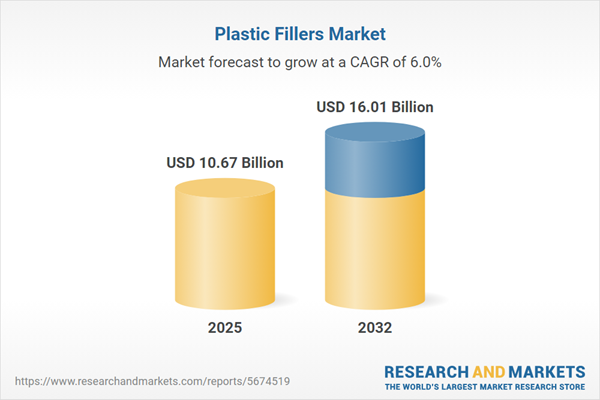Speak directly to the analyst to clarify any post sales queries you may have.
Senior stakeholders in the plastic fillers market face the challenge of adapting to complex industry trends. Evolving regulations, rapid technological advancements, and variable supply chains demand robust intelligence for alignment and operational success. Market visibility and agile strategies are crucial to protecting competitive positioning and supporting sustained progress.
Market Snapshot: Plastic Fillers Market—Growth Drivers and Opportunities
The plastic fillers market is experiencing steady momentum, valued currently at USD 10.06 billion, with projections indicating growth to USD 16.01 billion by 2032—reflecting a compound annual growth rate (CAGR) of 5.98%.
Expansion is driven by consistent end-user demand across sectors including automotive, construction, packaging, and electronics. These industries prioritize durability and performance improvements, relying increasingly on innovative filler technologies. Companies in this space continually upgrade product lines, integrate cost-efficient operations, and monitor shifting regulatory demands. Innovation remains vital, compelling market participants to stay alert to trends, enhance standards, and secure a resilient competitive edge.Scope & Segmentation of the Plastic Fillers Market
- Filler Types: Includes calcium carbonate (ground and precipitated), kaolin (calcined and hydrous), silica (fumed and precipitated), talc, mica (natural and synthetic), and wollastonite, all scrutinized for their roles in providing mechanical reinforcement, promoting thermal stability, and ensuring process efficiency.
- Forms: Granule and powder fillers offer versatility, facilitating streamlined processing and compatibility with a variety of manufacturing equipment for efficient throughput.
- Polymer Types: The market serves a broad range of polymers—ABS, HDPE, LDPE, LLDPE, polypropylene, and both flexible and rigid PVC—catering to evolving compliance requirements and specialized applications.
- End Use Industries: Applications encompass plastics, adhesives, coatings, cosmetics, paper, pharmaceuticals, and rubber sectors, supporting both high-volume basic material use and value-added functionalities for unique product needs.
- Applications: Key roles in automotive, construction, consumer goods, electronics, medical, packaging, and textiles emphasize performance and adherence to technical standards essential for long-term success in diverse end markets.
- Regions Covered: Strategic activity spans the Americas, Europe, Middle East and Africa, and Asia-Pacific. The market reflects local adaptations in jurisdictions such as the US, Germany, China, and India, driven by nuanced regulatory and supply chain demands.
- Leading Companies: Organizations such as Imerys S.A., Omya International AG, Sibelco Group NV, Minerals Technologies Inc., J.M. Huber Corporation, BASF SE, Evonik Industries AG, Lhoist Group, R.T. Vanderbilt Co., Inc., and Quarzwerke Group continually reshape their offerings to meet evolving technical and regulatory needs.
Key Takeaways for Senior Decision-Makers
- Integrating advanced and customizable plastic filler solutions enables organizations to meet strict durability and compliance standards across industry segments.
- Procurement teams are increasingly aligning sourcing practices with sustainability goals, emphasizing responsible raw material use and efficient processes to satisfy regulatory and stakeholder expectations.
- Building reliable supplier networks and establishing regional alliances improves supply chain stability, especially when facing global disruptions or sourcing shifts.
- Collaborative workflows across procurement, operations, and R&D drive agility, helping organizations respond promptly to evolving end-user requirements and capture new opportunities.
- Digitalization and predictive maintenance tools enhance quality assurance and production transparency, consistently reducing operational risks and maintaining product excellence.
Tariff Impact and Supply Chain Strategies
Recent US tariff changes have prompted many industry participants to pursue localized sourcing and manufacturing strategies. These adjustments foster cost predictability, reinforce regulatory compliance, and support operational resilience by enhancing transparency and adaptability throughout the supply chain, particularly in response to geopolitical uncertainties.
Methodology & Data Sources
This analysis draws on comprehensive secondary research, insights from sector experts, and in-depth technical publications. Findings undergo thorough cross-validation, ensuring senior leaders can rely on actionable market intelligence for procurement and strategic planning in the plastic fillers sector.
Why This Plastic Fillers Market Report Matters
- Delivers benchmarks for executive teams to evaluate operational efficiency and guide strategic resource allocation as market dynamics evolve.
- Promotes effective collaboration between procurement, sustainability, and R&D, expediting compliance and accelerating product launches.
- Equips organizations with the knowledge to proactively manage supply chain and regulatory risks, enabling swift adaptation to both external and internal changes.
Conclusion
This report empowers senior decision-makers to navigate regulatory developments, leverage technological progress, and fortify their supply chain, supporting responsible and strategic growth in the plastic fillers industry.
Additional Product Information:
- Purchase of this report includes 1 year online access with quarterly updates.
- This report can be updated on request. Please contact our Customer Experience team using the Ask a Question widget on our website.
Table of Contents
3. Executive Summary
4. Market Overview
7. Cumulative Impact of Artificial Intelligence 2025
Companies Mentioned
The companies profiled in this Plastic Fillers market report include:- Imerys S.A.
- Omya International AG
- Sibelco Group NV
- Minerals Technologies Inc.
- J.M. Huber Corporation
- BASF SE
- Evonik Industries AG
- Lhoist Group
- R.T. Vanderbilt Co., Inc.
- Quarzwerke Group
Table Information
| Report Attribute | Details |
|---|---|
| No. of Pages | 188 |
| Published | October 2025 |
| Forecast Period | 2025 - 2032 |
| Estimated Market Value ( USD | $ 10.67 Billion |
| Forecasted Market Value ( USD | $ 16.01 Billion |
| Compound Annual Growth Rate | 5.9% |
| Regions Covered | Global |
| No. of Companies Mentioned | 11 |









